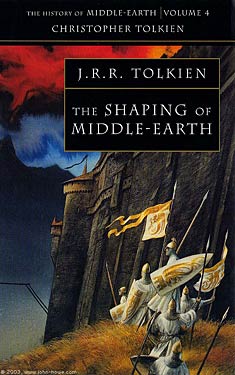JRR Tolkien
Completed 4/21/2016, reviewed 4/21/2016
4 stars
This is the fourth book in the History of Middle Earth
series. This book gives us the early
development of Tolkien’s thoughts on The Silmarillion. At this point in time, Tolkien was moving
away from the framework he used in The Lost Tales. It still contains the same mythology but is
being constructed and rewritten differently.
Once again, I followed along with The Tolkien Professor’s analysis to
help me understand the text and commentary.
As I progress through the series, the stories are becoming very
familiar. It’s the commentary that’s
much drier. Christopher Tolkien spends
most of his time detailing the evolution of the names as well as pointing out
the detailed differences between all the versions of the stories from The Lost
Tales up to the ‘30s, when much of this text was written. I still find all this fascinating even though
it is often dry as dust.
 The book begins with some fragments from the Lost Tales, but
moves into full swing with Tolkien’s first outline of the Silmarillion,
referred to as the Sketch. This is
followed by an initial fleshing out of the outline, called Quenta. The Quenta is basically the first prose
version of the Silmarillion that Tolkien ever produced. It has most of the stories from Lost Tales,
though they have evolved by about 10 to 20 years. The prose is often delicious. Now that I am
as familiar as I am with these stories going through the History, I’m finding
myself really paying attention to the prose to see how he retells these
immensely tragic stories.
The book begins with some fragments from the Lost Tales, but
moves into full swing with Tolkien’s first outline of the Silmarillion,
referred to as the Sketch. This is
followed by an initial fleshing out of the outline, called Quenta. The Quenta is basically the first prose
version of the Silmarillion that Tolkien ever produced. It has most of the stories from Lost Tales,
though they have evolved by about 10 to 20 years. The prose is often delicious. Now that I am
as familiar as I am with these stories going through the History, I’m finding
myself really paying attention to the prose to see how he retells these
immensely tragic stories.
The next two chapters are related. The first shows maps of the construction and
evolution of Middle Earth, the second is the Ambarkanta, the prose
cosmology. Tolkien discusses the makeup
of the atmosphere and the shape Middle Earth, beginning as a flat, uniform
earth and eventually becoming round and turning into continents looking vaguely
like Europe, Asia, and Africa.
The final chapters are annals of the Silmarillion. They are breakdowns of the stories of the
Silmarillion by year. There are two sets
of annals. It’s interesting that one of
them, the Annals of Bereliand, reads like you’d expect, terse outlines by year
of events. The other, the Annals of
Valinor, is almost like another go at a prose version of the stories. It is quite readable. Included in these chapters are Anglo-Saxon
versions of the annals. Needless to say,
don’t understand Anglo-Saxon, but it shows that Tolkien still had the idea that
the point of his stories was to create a mythology for England.
As I always say, this book is for the hard-core fan that
wants to see how Tolkien’s stories evolved over the years. You have to be quite the fan to read for a
fifth time the tragic tales of Turin Turambar or Beren and Luthien. But I find it interesting to see how the
stories changed and grew over the years and look forward to rereading the
Silmarillion again at some point with all this additional background swimming
around in my head. I give this book four
out of five stars.
No comments:
Post a Comment